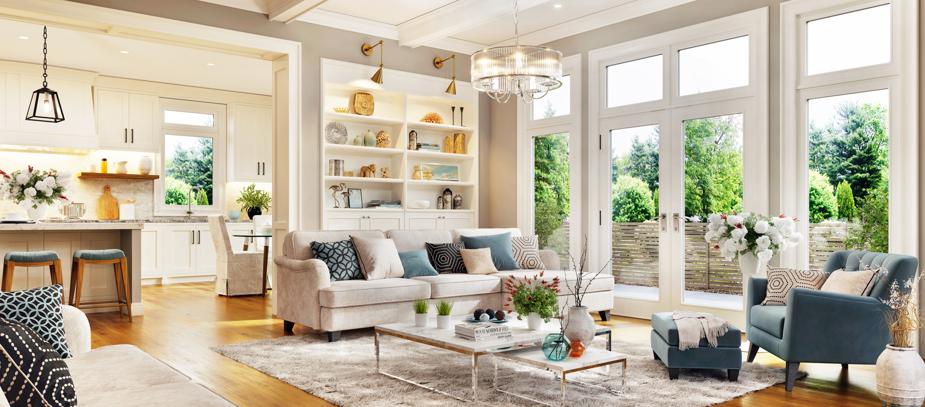Have you ever walked into a space and felt instantly at ease—like you could curl up with a book and stay forever? Or maybe you’ve entered a room that made you anxious for no clear reason, like something was just… off. That’s not a coincidence.
The design of your home impacts your emotions more than you realize. Everything from layout to lighting, colours, and even textures affects your mood, energy, and overall sense of well-being.
We like to think of interior design as purely aesthetic, but it’s actually an emotional science. Your home isn’t just a place you exist—it actively influences how you feel. A poorly lit, cluttered, or chaotic space can lead to stress and fatigue, while a well-designed, harmonious home can boost your happiness, creativity, and relaxation.
And no, it’s not just about adding plants and “calming” colors (though they help!).
- Layout Matters: The Subconscious Flow of a Space
Ever been in a room that just feels… wrong? Maybe there’s a couch blocking the entrance, or a dining table crammed into a corner that no one ever actually uses. That’s because the flow of a space directly affects how comfortable and functional it feels. Poor layout creates friction—you subconsciously hesitate before moving through a room, which leads to a subtle but real sense of unease.
Open-concept living, for instance, encourages social interaction, energy, and creativity. But too much openness can lead to a lack of structure and privacy, making it hard to focus or unwind.
On the flip side, closed-off spaces provide intimacy and security, which can be beneficial for relaxation and productivity. The way utilization has evolved to support well-being shows just how much layout influences not only our homes but our overall lifestyle.
If a space isn’t flowing well, don’t panic—you don’t need to knock down walls to fix it. Rearrange your furniture to create natural movement paths, use rugs to subtly define different areas, and ensure your most-used spaces feel inviting. A well-thought-out layout can instantly make a home feel more welcoming and less chaotic.
- The Ceiling Effect: How Height Changes Your Thinking
Ever notice how cathedral ceilings feel luxurious and freeing, while low ceilings create a cozy (or even cramped) atmosphere? That’s not just your imagination. Studies show that ceiling height affects the way we think and feel. Higher ceilings promote open-mindedness, creativity, and a sense of possibility, while lower ceilings encourage focus, detail-oriented thinking, and feelings of security.
This is why many luxury homes incorporate design elements that promote relaxation—open, airy spaces provide a sense of ease, while intimate, cozy corners make us feel grounded. The psychological impact of space planning is something architects have used for centuries to evoke emotion.
But what if your home has standard or low ceilings? You can still create the illusion of height. Use floor-to-ceiling curtains, install vertical shelves, or paint your ceiling a slightly lighter shade than your walls to draw the eye upward. Even adding tall plants or vertical artwork can elongate the space, making it feel airier and more expansive.

- The Lighting Factor: Why Bad Lighting = Bad Mood
Lighting is one of the biggest mood-setters in a home, yet it’s often overlooked. Natural light, in particular, plays a critical role in regulating your circadian rhythm—the internal clock that controls your energy levels and sleep patterns. That’s why bright, sunlit rooms make you feel alert and awake, while dim, shadowy spaces can lead to sluggishness and even seasonal depression.
Artificial lighting also affects your mood in surprising ways. Cool, white-toned lighting (like fluorescent office lights) enhances alertness but can feel harsh and clinical. Warm, yellow lighting, on the other hand, promotes relaxation and comfort, which is why it’s ideal for bedrooms and cozy living spaces. The popularity of Minimalist industrial aesthetics has introduced a new wave of lighting styles, balancing modern design with atmospheric warmth.
If a room feels off, start by adjusting the lighting. Maximize natural light by keeping windows clear of heavy drapes, add mirrors to reflect daylight, and switch to dimmable bulbs so you can control the ambiance. A simple change in lighting can completely transform the energy of a space.
- Clutter & Chaos: The Brain Overload Problem
Clutter isn’t just a visual nuisance—it’s a mental burden. Studies show that a cluttered environment increases cortisol (the stress hormone), making you feel anxious and overwhelmed. When your brain has to process too much visual information, it struggles to focus, leading to decision fatigue and mental exhaustion.
But here’s the thing: decluttering doesn’t mean stripping your home of personality. The goal is to create a space where everything has purpose and intention. Whether you prefer sleek, modern designs or a historic home that evokes nostalgia, having a well-organized home allows your brain to relax, making it easier to concentrate, unwind, and enjoy your surroundings.
If tackling clutter feels overwhelming, start small. Focus on one surface at a time, invest in stylish storage solutions, and be intentional about what stays and what goes. Even reducing visual noise—like hiding cables, organizing bookshelves, or keeping countertops clear—can have an instant calming effect.
- The Texture Trick: Why We Crave Tactile Comfort
Ever notice how luxury hotels feel different? It’s not just the lighting or decor—it’s the textures. Your brain subconsciously registers how different materials feel, which influences how comfortable and inviting a space feels. Hard, glossy surfaces (like metal or glass) can feel cold and sterile, while soft, textured elements (like wool, velvet, or linen) create warmth and coziness.
Think about how a plush rug under your feet instantly makes a room feel more inviting. Or how curling up with a knit throw on a leather chair adds contrast and comfort. Layering different textures not only makes a space look better—it makes it feel better, too.
To add warmth and depth to your home, mix and match textures thoughtfully. Pair natural elements like wood and stone with softer textiles like cotton, fur, or silk. The goal is to create contrast that engages your senses while making the space feel balanced and lived-in.
For those seeking an elevated living experience, consider homes designed with these principles in mind—where thoughtful textures, tree-lined streets, and spacious interiors naturally support well-being.
Final Thought: Your Home = Your Emotional Ecosystem
Your home isn’t just where you sleep and store your belongings—it’s an active force that shapes your daily mood, energy, and mental clarity. Every design choice you make, from furniture placement to lighting, color, and texture, impacts how you feel in that space.
The good news? You don’t need a massive renovation to improve your home’s emotional impact. Simple, intentional tweaks—like optimizing your layout, enhancing lighting, and decluttering—can create a space that doesn’t just look good but feels good, too. Because when your environment supports you, everything in life flows a little better.
And really, isn’t that the whole point of home?
For expert guidance in finding a home that truly enhances your lifestyle, Harvey Kalles Real Estate Ltd. offers insight and expertise in luxury real estate and curated living.

